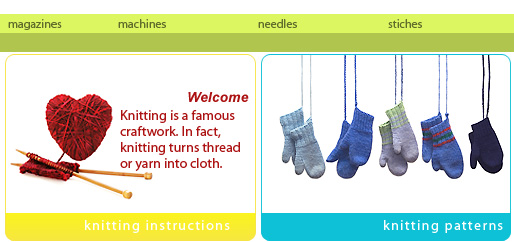Knitting Machine
Knitting machines are used to create knit fabrics and are also known as a knitting frame, hand knitting machine and knitting loom. Knitting machines can be operated by hand or by motor. Mechanical punch cards, push buttons and computers are used to select the pattern stitches.
Lee invented the first knitting machine. There was a story behind his invention and a painting was displayed about Lee in the Stocking Framer's Guildhall in London. Lee invented the machine because his girlfriend preferred knitting. Another story produced by Alfred Elmore is how Lee's ideas are formed for the knitting machine, as he watched his wife knitting. His painting is popularly called 'The Invention of the Stocking Loom'. Lee demonstrated the operation of the machine to Queen Elizabeth I, for a patent right, but the Queen refused it. Initially, the knitting machine had 8 needles to the inch and later it increased to 20 needles to the inch. Lee started knitting stockings from silk and wool. Lee changed his workplace to France, but unfortunately he did not flourish in the business. He died in Paris and his workers sold the machines in London.
Later John Ashton assistant of Lee improved the knitting machine and added the mechanism 'divider' to the machine. The business started developing by the spinners of Spitalfield village. The demand for stockings made of cotton rise. Knitting by machines was accepted, but it was too expensive for the knitters to buy. Knitters started to hire the machines and started knitting in the machine. In the year 1758, Jedediah Strutt, attached a device called the 'Derby rib'. The trade moved towards Nottingham, and the workers were running short of raw materials. The spinners found great difficulty in using cotton whereas the Gloucester, spinners found easy to use cotton and they were competing with Nottingham spinners. Later Richard Arkwright, operated the machine by horsepower. Nottingham produced cotton stockings, Derby used silk and Leicester used wool.
There are two types of models known as industrial and domestic, to create rectangular and tubular fabric. There are two flat beds facing each other in the double bed machines. They are used to create purl and plain rib fabric. Single bed machines can also have rib attachment to produce same purl and plain ribs fabric. In the domestic model, 22 latch hook needles are used to hold the stitches. Across the bed of needle, a carriage or cam box is passed to create the next stitch. We can select a particular needle with the help of punch card to pass through the carriage. The machine knits 'fair isle' pattern and also the plating and knit weaving patterns.
Weft knitting method is used in domestic knitting machines and the fabric resembles the fabric knitted by hand. Knitting by domestic knitting machine is faster than in hand knitting. The texture of fabric knitted by machine is even the texture knitted by hand. Tuck stitches are easily made in machine knitting whereas the garter stitch is easier in hand knitting.
